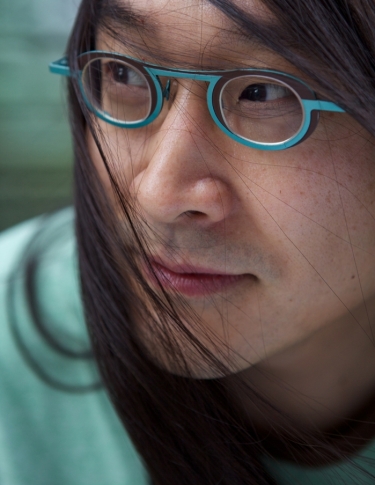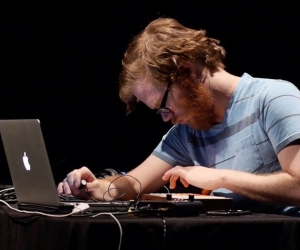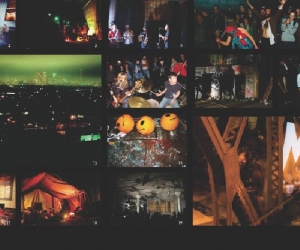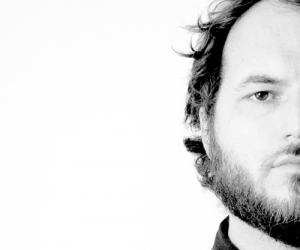
On the first Sunday in March 2011, at the Betty Oliphant Theatre in Toronto, Gregory Oh performed in a concert featuring the works of British composer Jonathan Harvey. Oh wore a grey-collared shirt and black pants. His Fluevog shoes were shiny black with aqua laces, which even under his piano caught the lowest light. At one point during the first piece, Scena, he was picking piano strings with a credit card. His eyes would bug out at certain notes.
The next piece on the concert saw sixteen members of the ensemble come onstage. Oh followed, not to position himself at the piano, but to stand with his back to the audience to lead the ensemble in a performance of Geoff Palmer’s Flute Concerto: Cancri 55. When Oh conducts, there’s no flash. He is very precise—not only with his direction, but with his own movements. When the piece ends, he makes eye contact with the ensemble and nods approval with a slight smile on his face. Then, with a quick flip of his hands, he signals the players to stand for their applause.
This concert reveals only two sides of Gregory Oh.
“OK, let’s shit-talk Greg Oh now!”
The enthusiastic order came from Richard Marsella, a.k.a. Friendly Rich, as he, members of his group the Lollipop People, and friends of the band chatted outside a small music venue in Toronto. It was a cold Tuesday night in March. The group had just finished a gig, and now they were going to roast an absent collaborator with exaggerations and half-truths . . . just for fun.
“His hair goes down to his butt,” someone shouted. His black hair actually falls to the small of his back.
“He’s always taunting me online. I had to block him,” said Benjamin Mueller-Heaslip, who has been covering for the busy Oh on piano with the Lollipop People.
“He chooses perverted repertoire,” Marsella said. “I heard him play the Aaron Gervais porno piece. Like, all the lyrics were drawn from porn or something. Really fucked-up piece.”
Marsella was probably referring to Gervais’ Culture No. 2 or Shoot Like a Film Star, which takes its lyrics from e-mail spam.
“Greg definitely injects his weird video-game introvert side into what he does as a musician.”
“Greg has a group of weirdo students and he teaches them John Zorn’s Cobra and shit,” Marsella said. “He’s what the University of Toronto music faculty should be.”
“He’s into football,” someone shouted. Oh is quite passionate about American college football.
“The only weirder guy I’ve ever met in music,” Marsella states, “is the porno-making classically trained accordionist that I know.”
As the roast session wound down, Marsella became a bit more reflective, revealing the underlining respect and admiration that he has for Oh. Earlier that day, at the University of Toronto, Marsella led Oh, some Lollipop People, and a group of Oh’s “weirdo students,” called the Chainsaw Ensemble, through his arrangement of Modest Mussorgsky’s Pictures at an Exhibition.
“I felt honoured today,” Marsella said, “injecting that bit of weirdness into U of T, and it was all possible because of Greg. I’m going to send him a really gushy e-mail thanking him for letting us stain some ears.”
And six days later Marsella had written a six-hundred-word essay he entitled An Ode to Oh.
Gregory Oh—pianist, curator, artistic director, and conductor—does have his eccentricities. But if one looks past the crocheting, love of nice stationery and pencils, winter cycling, and ten pairs of Fluevogs, one finds a musician committed to contemporary classical music and working very hard to keep it real.
When you speak to Oh’s musical collaborators, the talent they mention before they touch on his piano playing or his conducting is his ability to put together great projects. Whether it is with his group Toca Loca or something Oh has devised for Toronto’s Music Gallery, where he is the curator of post-classical music, he comes up with ideas that are not only novel, but carry some significance that raises them above their surface quirkiness.
One idea that seems flippant at first—but that Oh treats seriously even though he doesn’t think the project will ever happen—is a performance of American composer Morton Feldman’s six-hour-long String Quartet II that would require audience members to swipe in and out of the venue with magnetic-stripe cards. The longer they stay for the piece, the more of their high admission fee they’d get back. People who listened to the whole performance without interruption would make a small profit. A friend of Feldman’s who has heard of Oh’s plan calls it very disrespectful. Oh, however, has noble reasons behind this funny project.
“It encourages people to stay and listen,” Oh says. “You can’t listen to Feldman for five minutes, I think, and really enjoy it. But when you listen to something for six hours, you get the context and you start to understand the music in the way that it needs to be understood. Also, there’s the recognition that active listening is hard work and should be rewarded.”
Another idea that seemed like a gag was his “Lunaire” hoax. He once proposed “revealing” that part of Arnold Schoenberg’s Pierrot Lunaire was based on Renaissance madrigals; he’d then have that part “madrigal-ified” and performed. For 2010’s X Avant festival at the Music Gallery, which Oh curated, he did just that. The stunt, however, was more than a stunt. On one hand, it played with the reception of a work: does its historical accuracy matter more than the sounds themselves? While that question may not have been answered, the performance, to Oh’s delight, reinvigorated a work he considered flawed and boring.
Another of Oh’s ideas that made its way into a project that was premiered at X Avant is the Halo Ballet, a choreographed dance that takes place within the virtual world of a first-person-shooter video game. Four gamers move virtual space marines, or in the context of the performance “Halorinas,” to live musical accompaniment. A fifth gamer acts as the camera operator, whose view projects the actions of the four dancers on screen. Oh tapped the talents of composer Aaron Gervais for music for the ballet and of choreographer Julia Aplin for the virtual dancers’ moves.
“One of the problems with choreographing some of the moves was figuring out how to do them within the game platform without the dancers inadvertently killing each other,” Aplin says “There’s this one section where they blow up a jeep. It’s weird, but it’s beautiful to see this jeep go up with fireworks, and it spins in the air and then lands and bounces. It’s really quite interesting. But, at the same time, you have to be careful because it’s unpredictable. The jeep sometimes lands on people and you loose a dancer in the middle of the piece. It happened quite a bit in rehearsal. Thank goodness it didn’t happen in performance. You don’t usually have that worry for a live performance.”
Oh is a passionate gamer. He claims that he is avoiding the purchase of a new laptop because the new machine would allow him to buy all these new games. In other words, his solution to avoiding addiction is not buying the drugs. However, he has an interest in video games that goes beyond racking up high scores and discovering Easter eggs. When he encountered machinima—the use of games with 3-D graphics engines, such as Halo (hence the Halo Ballet, previously mentioned), for computer animation or art—he was intrigued. Instead of making recorded art, he wanted to take the video-game art into his area of interest, live performance.
The provocative nature of Oh’s projects—money back for a Feldman show, calling Schoenberg boring, video games—has led Jonathan Bunce, artistic director at the Music Gallery, to call Oh “a punk rocker of the classical world.” The analogy is apt. The punks of the late ’70s—as the popular story goes—were trying to reinvigorate the bloated and stagnant realm of rock. Oh simply has his sights set a little higher than the punks. He’s not only after the classical world, but contemporary music too.
Oh has joked that the only time he really wanted to play piano was in 1978 when he was around four years old. He saw his two older siblings playing and going to lessons and was excited by the prospect of hitting the keys. Except for one year of high school in which Oh was a starting offensive lineman, he has played piano continuously. He went on to the University of Toronto to study performance. A masters degree in piano performance at U of T followed, as well as a masters from the University of Michigan, with a focus on collaborative piano with vocalists.
Around 2001, he formed Toca Loca, a three-member ensemble, with percussionist Aiyun Huang, who he knew through their undergraduate studies at U of T, and pianist Simon Docking, who Oh connected with at the Banff Centre. “I think the first show that was actually by Toca Loca was—we have disagreements about this—was in early 2002 at the Music Gallery in Toronto,” Docking says. Part of Docking’s uncertainty over the start of Toca Loca comes from the flexibly with which Oh uses the name and the group. As Huang puts it: there is Toca Loca and Toca Loca Nation, the latter being the collaborators that Oh brings in to fill out projects, some of which may or may not include Huang and Docking. “Greg’s vision for Toca Loca is that it’s not just a straight ensemble that does concerts in a rigid format,” Docking says. “He sees it as a platform for all kinds of things to happen. So sometimes he’ll say to me with a bit of a smirk, ‘Oh, Toca Loca played such and such a place recently without you.’”
In spite of the ad hoc premise of the group, plus the geography that separates them—Oh in Toronto, Huang in Montreal, and Docking in Halifax—the trio of virtuosic musicians clicks. They continue to perform together, but only if they feel strongly about a project. Each member stresses that they have to believe in the project, whether it’s a commission or tour, before undertaking it.
One such project is P*P, (pronounced pop). In 2006, Oh began commissioning works for Toca Loca, which would lead to a Canadian tour and an album. Oh gave fourteen composers two parameters for their works: a short time-limit of five to ten minutes and the word p*p. It was up to the composers to fill in that asterisk. Most chose the obvious pop. “P*P was a puzzle to solve,” says Aaron Gervais, whose piece Shoot Like a Film Star is on the album, “which is typical of the projects and challenges that Greg comes up with—open-ended ambiguities that foster the creative process.” Gervais’ piece features the band members shouting, speaking, singing, and squawking the line, “Do you crave to shoot like a film star, bro?” to frenetic piano and percussion. Another work that has vocals at the fore is Andrew Staniland’s Made in China. The piece was originally an operatic number that featured tenor, percussion, and piano. Staniland modified it for Toca Loca, in which version Oh drones the title lyrics to frantic, repetitive instrumental lines. Staniland acknowledges that Toca Loca’s interpretation of his song can be quite polarizing. “People either love it of hate it,” Staniland says. “But that’s Toca Loca—avoiding the middle of the road.” Other songs range over the off-rock, guitar-riffy No Time by Myra Davies, the country twang of Laura Barrett’s Robot Ponies, and Nicole Lizée’s Promises, Promises, which moves in the realm of moody Ninja Tunes-like electronic music.
“There is something incredibly freeing about playing pop,” says Oh. “And generally, pop takes from classical but doesn’t give a lot back. I was trying to find out what we can take from pop music.” Oh goes on to stress that P*P isn’t a crossover album. It’s not as if Toca Loca was “classicalling up” The Beach Boys. The members operated within the new-music tradition first. As a result, P*P has more in common with New York’s Bang on a Can’s approach to pop and classical than, say, Toronto’s Art of Time Ensemble. P*P did lead the group to Berlin in 2009 to the Club Contemporary Classical (C3) Festival at the seminal techno club Berghain. On their night, Toca Loca was preceded by Kathleen Supové, a boundary-pushing pianist, and followed by pioneering Detroit techno producer Jeff Mills.
Released in 2009, P*P was Toca Loca’s debut album. Their four-song follow-up CD, Shed, came out this year; but some of its pieces have been in the group’s repertoire pre-P*P, including another Staniland composition, Adventuremusic: Love Her Madly. Since Toca Loca is composed of three strong musical personalities, they don’t always share the same enthusiasm for the works they perform. Adventuremusic has the distinction of being a group favourite. The first section, labelled “Driven,” starts with repetitive, propulsive tremelos on the pianos, punctuated with wood-based percussive clacks. The pianos and percussion work toward a textural and rhythmic climax. When the pianos stop, Huang then flexes her percussive chops, after which an electroacoustic part enters to introduce the second section. A third of the way into the piece, all the initial momentum of the work is gone. Then Oh and Docking’s pianos, each with five prepared strings (masking tape or screws), begin to assert themselves with short notey outbursts that grow and grow until they, too, come to an end.
Ma’Mounia by Heinz Holliger showcases Huang’s percussion skills. This piece led to her win at the 2002 Geneva International Music Competition. Another standout from Shed, is Half-Remembered City by Dai Fujikura. It is a one-piano, four-hands piece, written originally for a married couple. However, the composer likes the idea of his piece possibly leading to other hookups. So far, this work has only led to the intertwining of Oh and Docking’s arms. The rapid, gestures and sudden chords require the two pianists to bob and weave like boxers. And they have drawn blood in the course of performing this work.
Despite the obvious piano virtuosity shown by Oh, he is quite modest about his skills. “Simon and I are very different players,” Oh says. “We each have our strengths and weaknesses. My joke about how I divide the piano parts within a work is I figure out which one has more quintuplets and I give the quintuplets to Simon. His quintuplets are so much better than mine—which is both true and a joke . . . but they are better than mine.”
Another feature that Oh brings not only to Toca Loca but to other ensembles with which he collaborates is his skill as a conductor. Oh got his first taste of conducting while at the Banff Centre in 2000. “The first thing I conducted was Thérése Raquin by Michael Finnessy,” Oh says. “It’s an incredibly crazy score. It doesn’t look so bad, but everything is in a different time. The voices and the piano all have embedded rhythms and they are all different.” Docking remembers that Oh met this challenge brilliantly. Also, Docking says that Oh has the remarkable skill of being able to push people without making them feel uncomfortable.
So, Oh is a musical triple threat, with his abilities at the keys, in front of the players, and planning projects. But, as you look more closely, you see that the threat is more than triple.
On a sunny day this past April, Oh sat at his kitchen table in his condo and trash-talked classical music. Behind him, by his front door, sat his five-foot by five-foot grand piano with scores and papers piled on top. Next to it was a Nord Stage EX Compact keyboard hooked up to a number of effects pedals, including a looper. He had to practise Simulakra, a new piece by Nicole Lizée that he would be premiering at the Open Ears festival in Kitchener, Ontario, in roughly two weeks. The performance would feature Oh’s voice and keyboard, both embellished with the effects, and a brass and percussion section. Oh needed to work on his pedal footwork. Without that component mastered, the piece would fall apart.
But the practising would come later. At that moment, he was on a tear. He called classical music McDonalds dressed up like a fancy restaurant: all that standard repertoire that universities feed to students and symphonies to concert-goers was an unhealthy diet of the same comfort food. “Beethoven is incredible; there’s no debate there,” Oh said. “Strauss is amazing. Bach is great. Chopin wrote beautiful things. Whatever. I love classical music. I don’t love the reasons we choose to listen to this narrow window of music.”
That narrow window is from Bach to Brahms (“Debussy could exit stage left from the canon. People would cry, but they would get over it.”) and it comprises composers and works that the classical-music-listening public is too fixated on. “We are a do-re-mi society. But there are so many scales—not even scales, but sounds—that are excluded.” Moreover, the twentieth century doesn’t provide the alternative. “The two most culpable people in the destruction of classical music are Arnold Schoenberg and Steve Reich,” Oh said, with a bit of a laugh after launching such a polemical statement. “Schoenberg destroyed everything and Steve Reich put it back together again and gave one solution for it. Schoenberg is the reason why people hate listening to what they think is modern music—the atonality, for example. Steve Reich is equally culpable, because people think they can listen to him and enjoy contemporary music.” As Oh said those words, Reich’s Writings about Music sat on the table. Oh has played with Reich, teaches his music, and thinks the act of playing the composer’s works can be sublime. The new-music world, however, just like the classical one, needs to shake off the influence of its heavy hitters.
For Oh, it all comes down to the way people listen. Most people listen to be comforted; they listen passively. Oh cites Canadian composer John Beckwith’s idea of active listening. The listener should be engaged, possibly uncomfortable, and that experience is ultimately more rewarding. But how does one move away from comfortable and easy listening to active listening? “Oh boy. I just attack. I’m the revolution, not the new government,” Oh said. While his line was very punk rock, he said it with a bit of disbelief, not revolutionary zeal. Possibly, as with Richard Marsella’s tear on Oh, Oh’s riffing on modern musical ills got away from him. He may not have thought that he had any of the answers, but Oh’s projects—Toca Loca, the Halo Ballet, the re-imagined Pierrot Lunaire—seem designed to push listeners toward the active mode. An answer may have also been at the keyboard behind him, with all the effects pedals and the newly commissioned work he needed to master.
Image: Gregory Oh. Image by: Adam Coish.


